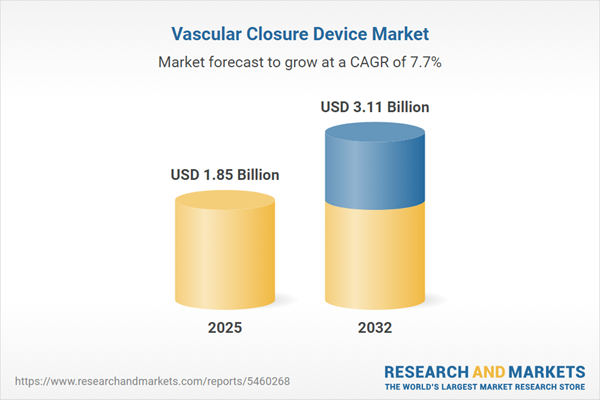Speak directly to the analyst to clarify any post sales queries you may have.
The vascular closure device market is rapidly evolving, driven by procedural advances and growing demand for effective solutions in cardiovascular care. Senior executives face an expanding landscape characterized by shifting technologies, new regulatory requirements, and changing global sourcing strategies.
Market Snapshot: Vascular Closure Device Market Size and Growth
The vascular closure device market grew from USD 1.71 billion in 2024 to USD 1.85 billion in 2025. It is projected to continue expanding at a CAGR of 7.73%, reaching USD 3.11 billion by 2032. Robust growth is attributed to the shift toward minimally invasive cardiovascular and peripheral procedures, increased focus on patient outcomes, and evolving reimbursement frameworks supporting fast recovery and hospital efficiency.
Scope & Segmentation of the Vascular Closure Device Market
This report delivers a comprehensive analysis of technologies, clinical applications, regional activity, and competitive positioning in the vascular closure device ecosystem.
- Product Types: Clip based devices, Collagen plug devices (bovine and synthetic), External compression devices, Sealant based devices (chitosan, polyethylene glycol), Suture based devices
- Procedure Types: Diagnostic procedures (angiographic procedures, hemodynamic monitoring), Interventional procedures (cardiovascular interventions, peripheral vascular interventions)
- Access Sites: Femoral access, Radial access
- End Users: Ambulatory surgical centers, Clinics, Hospitals
- Distribution Channels: Direct sales, Third party distributors
- Regional Coverage: Americas (United States, Canada, Mexico, Brazil, Argentina, Chile, Colombia, Peru), Europe, Middle East & Africa (United Kingdom, Germany, France, Russia, Italy, Spain, Netherlands, Sweden, Poland, Switzerland, United Arab Emirates, Saudi Arabia, Qatar, Turkey, Israel, South Africa, Nigeria, Egypt, Kenya), Asia-Pacific (China, India, Japan, Australia, South Korea, Indonesia, Thailand, Malaysia, Singapore, Taiwan)
- Companies Covered: Abbott Laboratories, Terumo Corporation, Teleflex Incorporated, Cardinal Health, Boston Scientific, Becton, Dickinson and Company, Merit Medical Systems, B. Braun Melsungen AG, Cook Medical, Lake Region Medical
Key Takeaways for Decision-Makers
- Adoption of vascular closure devices is accelerating, supported by clinical trends favoring minimally invasive intervention and need for faster patient ambulation across care settings.
- Mechanical clip systems, collagen plug technologies, and bioresorbable sealants are all contributing to a wider suite of closure options, allowing tailored device choices for diverse procedures.
- Technological advancements have enhanced sheath compatibility, ergonomic deployment, and accuracy, reducing learning curves and supporting improved post-procedural outcomes.
- Regulatory and reimbursement changes emphasize real-world performance, requiring manufacturers to invest in robust clinical trials, post-market surveillance, and comprehensive documentation.
- Regional differences in healthcare infrastructure and market access necessitate adaptable distribution and training strategies, particularly in emerging Asia-Pacific and Middle East markets.
- Industry leaders are strategically expanding portfolios through R&D, acquisitions, and digital service initiatives such as predictive analytics for inventory and utilization management.
Tariff Impact: Navigating New Costs and Sourcing Challenges
Tariff adjustments in 2025 have altered sourcing, supply chain, and pricing dynamics for vascular closure devices. Increased duties on imported medical components are influencing procurement strategies, prompting stakeholders to explore alternative suppliers, shift to domestic manufacturing, and renegotiate long-term agreements. Hospitals and distributors are managing cost pressures through scenario planning, group purchasing amendments, and evaluation of price pass-through in procurement decisions.
Methodology & Data Sources
The insights in this report are drawn from a hybrid research methodology incorporating interviews with clinical and procurement leaders, targeted surveys, and extensive secondary analysis of published literature, regulatory filings, and company disclosures. Triangulation and advanced frameworks were employed to ensure objective, reliable findings.
The Importance of This Report for Stakeholders
- Gain clarity on evolving market and regulatory factors influencing product selection, sourcing, and clinical pathways.
- Equip leadership teams with actionable intelligence for capitalizing on growth opportunities and mitigating operational risks across regions and supply chains.
- Benchmark key competitors, new technologies, and innovation initiatives shaping current and future market dynamics.
Conclusion
This report provides senior leaders with actionable insights into evolving technologies, sourcing strategies, and competitive intelligence in the global vascular closure device market. Informed, agile responses will unlock opportunity and long-term success in this dynamic sector.
Additional Product Information:
- Purchase of this report includes 1 year online access with quarterly updates.
- This report can be updated on request. Please contact our Customer Experience team using the Ask a Question widget on our website.
Table of Contents
3. Executive Summary
4. Market Overview
7. Cumulative Impact of Artificial Intelligence 2025
Companies Mentioned
The companies profiled in this Vascular Closure Device market report include:- Abbott Laboratories
- Terumo Corporation
- Teleflex Incorporated
- Cardinal Health, Inc.
- Boston Scientific Corporation
- Becton, Dickinson and Company
- Merit Medical Systems, Inc.
- B. Braun Melsungen AG
- Cook Medical LLC
- Lake Region Medical, Inc.
Table Information
| Report Attribute | Details |
|---|---|
| No. of Pages | 186 |
| Published | November 2025 |
| Forecast Period | 2025 - 2032 |
| Estimated Market Value ( USD | $ 1.85 Billion |
| Forecasted Market Value ( USD | $ 3.11 Billion |
| Compound Annual Growth Rate | 7.7% |
| Regions Covered | Global |
| No. of Companies Mentioned | 11 |









